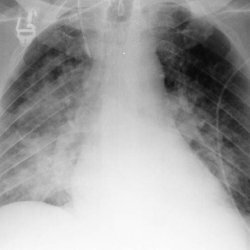Antibiotic therapy of pneumonia

Today, as before, antibiotic therapy for pneumonia is an actual topic, because often tactical and strategic mistakes during treatment of this disease significantly affect the outcome of treatment. Today, there is a large number of antibacterial drugs, which allows to expand the possibilities of antibacterial therapy of different infections. However, there is another side - the doctor should know about these drugs all - pharmacokinetics, the spectrum of action, side effects, dosage, and also be able to navigate in matters of clinical pharmacology, microbiology and other related disciplines.
In addition, from the doctor in the appointment and conduct of therapy required to take a whole range of measures, each of which determines the effectiveness of the treatment.
The physician is also guided by parameters such as
- when prescribing AT. The choice of the initial drug for empirical therapy.
- Dosage and route of administration of the drug.
- Evaluation of the effectiveness of the selected drug.
- Duration of antibiotic therapy.
- Probability of stepwise therapy.
Selection of
For the treatment of pneumonia, the main factors determining the choice of the initial preparation are:
- antimicrobial spectrum of the effect of the selected AP;
- clinical and epidemiological situation;
- pharmacokinetics of AP;
- sputum color data for Gram;
- severity of pneumonia;
- trend and the possibility of antibiotic resistance;
- the possibility of stepwise therapy;
- drug safety in a specific situation;
- the cost of the selected AP.
Dosage
For the treatment of pneumonia, inadequate doses of the drug are often prescribed. Appointment in this case as excessive doses, and insufficient. An insufficient dose of the drug is not able to create a concentration of the drug in the blood, which would correspond to the eradication of the pathogen. In this case, there can be no question of efficacy, besides, such a situation can cause the development of resistance of the microorganism.
The error in choosing the best dose is associated not only with the recommendation of an insufficient single dose, but also with an incorrect dosing regimen. The route of administration of the drug is determined by such factors as the general condition of the patient;Severity of pneumonia, pharmacokinetic characteristics of an antibacterial drug.
Evaluation of the effectiveness of
Typically, the first 48-72 hours after initiation of treatment are considered the most intense period for assessing the effectiveness of the appointment. If the prescribed drug is effective, then during this period the body temperature will normalize or decrease, signs of intoxication decrease.
If the fever is not expressed from the very beginning, or there is none at all, then to assess the effectiveness of the doctor will focus on other signs of intoxication - headache, cerebral symptoms, anorexia. The indicator of effectiveness will be the factor that during this period of time the disease will not progress.
Duration of antibiotic therapy
The course of treatment for hospital pneumococcal pneumonia( if it occurs without complications) is from seven to ten days. Mycoplasmal and legionellosis pneumonia is treated longer, about 3 weeks, since these etiologic agents have intracellular localization. Complicated pneumonia caused by staphylococcus( abscesses, pulmonary destruction, empyema) requires a minimum of 3-week antibacterial therapy.
Stepwise therapy
This method of therapy is rarely used. Stepwise therapy as the first stage provides for parenteral administration of AP, then a transition to oral administration of the same drug( the transition is made to achieve a clinical effect).But the application of this method of therapy is possible if AP has both oral and parenteral dosage form. As studies show, this method of therapy does not worsen the prognosis of the disease and the results of treatment of pneumonia.
Stepwise therapy has advantages - it provides greater comfort of treatment, shortens hospitalization time and the probability of continuing therapy on an outpatient basis, reduces the cost of treatment.



